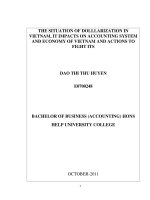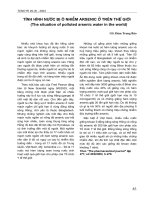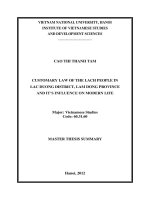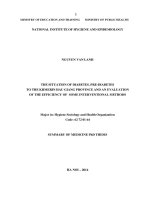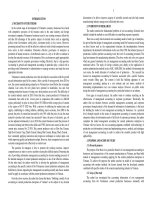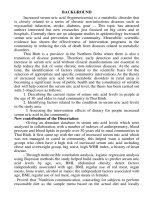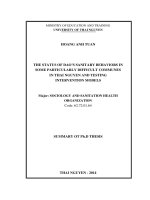the situation of dolllarization in vietnam, it impacts on accounting system and economy of vietnam and actions to fight its
Bạn đang xem bản rút gọn của tài liệu. Xem và tải ngay bản đầy đủ của tài liệu tại đây (795.04 KB, 63 trang )
1
THE SITUATION OF DOLLLARIZATION IN
VIETNAM, IT IMPACTS ON ACCOUNTING SYSTEM
AND ECONOMY OF VIETNAM AND ACTIONS TO
FIGHT ITS
DAO THI THU HUYEN
E0700248
BACHELOR OF BUSINESS (ACCOUNTING) HONS
HELP UNIVERSITY COLLEGE
OCTOBER-2011
2
THE SITUATION OF DOLLLARIZATION IN VIETNAM, IT IMPACTS ON
ACCOUNTING SYSTEM AND ECONOMY OF VIETNAM AND ACTIONS TO
FIGHT ITS
BY
DAO THI THU HUYEN
E0700248
Graduation Project Submitted to the Department of Business Studies,
HELP University College, in Partial Fulfilment of the Requirements for
the Degree of Bachelor of Business (Accounting) Hons
OCTOBER- 2011
3
DECLARATION OF ORIGINALITY AND WORD COUNT
I hereby declare that the graduation project is based on my original work except for
quotations and citations which have been duly acknowledged. I also declare that it has
not been previously or concurrently submitted for any other course/degree at HELP
University College or other institutions. The word count is _____ words.
(Signed)
_____________________
DAO THI THU HUYEN
Date:
4
ACKNOWLEDGEMENT
I have support, assistance and encourages of many people to complete my graduation
project.
First of all, I would like to thank my teacher and also my supervisor Dr. Le Van Lien,
International School, Vietnam National University Hanoi. He has kindly helped me and
supported me by give so much useful advises and instructions.
Besides, I also would like to extend my special thanks to managers and accountants of
my survey’s companies, my neighborhood and other people in Thanh Xuan District who
have help me to carry out the survey. I want to thank them for all their support, interest
and valuable hints.
Moreover, I would like to delicate this project to my family who always loving,
supporting and believing in me.
5
THE SITUATION OF DOLLLARIZATION IN VIETNAM, IT IMPACTS ON
ACCOUNTING SYSTEM AND ECONOMY OF VIETNAM AND ACTIONS TO
FIGHT ITS
By
DAO THI THU HUYEN
OCTOBER- 2011
Supervisor: Dr. Le Van Lien
ABSTRACT
In recent years, “Dollarization” becomes a familiar word in Vietnam. Nowadays,
Vietnam is amalgamating into the global economy, thus Vietnam has to use U.S dollar
in trade and invest activities. Additionally, the habit of use of U.S dollar in daily
activities and trading activities of Vietnamese people and firms lead to the dollarization
ratio of Vietnam higher than countries in the same area. Therefore, dollarization is a
hard situation in Vietnam now. Dollarization has strong impacts on accounting system of
Vietnam’s firms. Furthermore, Dollarization also has both advantages and disadvantages
impacts on Vietnam’s economy. My graduation project aims to discover how
dollarization impacts on Vietnam’s accounting system and economy, it also shows some
explanation about dollarization and actions to fight its.
6
TABLE OF CONTENTS
Declaration of Originality and Word Count
3
Acknowledgement
4
Abstract
5
Table of Content
6,7
List of Figures
8
List of Abbreviations
9
CHAPTER 1 INTRODUCTION
1.1 Overview
10-12
1.2 Dollarization in Bank Activities
12-14
1.3 Dollarization in Trade and Invest Activities
15-18
1.4 Motives for more investigation
18
CHAPTER 2 LITERATURE REVIEW
2.1 Form of Dollarization
19-21
2.2 Types of Dollarization
21-24
2.3 The Origin of Dollarization
24-25
2.4 Causes of Dollarization in Vietnam
25-28
2.5 Accounting Dollarization
28-30
2.6 Accounting for Changes in Foreign Exchange Rates in Vietnam
30-32
CHAPTER 3 METHODOLOGY
3.1 Research Objective
33
3.2 Research Methodology
33
3.3 Data Source
33-34
3.4 Research Method
34
3.5 Research Tool
3.5.1 Questionnaire
34-35
3.5.2 Personal Interview
35
3.5.3 Annual Report
35
3.6 Data Collection
35-36
3.7 Sampling
7
3.7.1 Sample Population
36
3.7.2 Sample Frame
36
3.7.3 Sample Size
36
3.7.4 Sample Techniques
37
3.8 Limitation
37
CHAPTER 4 FINDING AND ANALYSIS
4.1 The Impacts of Dollarization on Accounting System and Economy of
Vietnam
4.1.1 The Impacts of Dollarization on Accounting System
38-42
4.1.2 The Impacts of Dollarization on Vietnam Economy
42-45
4.2 Scheme of Actions to Fight Dollarization in Vietnam
45-47
4.3 Findings from Questionnaire Survey
4.3.1 Companies Survey
47-52
4.3.2 People Survey
53-56
CHAPTER 5 CONCLUSION
57-58
REFERENCES/BIBLIOGRAPHY
59-61
APPENDICES
62-63
8
LIST OF FIGURES
Figure 1.1: The Dollarization Ratios of Vietnam
11
Table 1.1: U.S dollar Outstanding Loans on Total Loan of Vietnam
13
Figure 1.2: Exchange rate of VND and USD from 1988 to 2010
16
Figure 1.3: FDI of Vietnam from 1990 to 2009
17
Table 2.1: Forms of Dollarization
20
Figure 2.1: Foreign Reserve Currencies 2006
21
Figure 2.2: International Visitors to Vietnam
27
Figure 2.3: Remittances of Vietnam
28
Figure 4.1: Company’s Respond Summary
48
Figure 4.2: Frequently level of using USD
49
Figure 4.3: Activities that use USD
50
Figure 4.4: Statement
51
Figure 4.5: Methods
52
Figure 4.6: People’s Respond Summary
53
Figure 4.7: Level use USD of Vietnamese
54
Figure 4.8: Activities that use USD
55
9
LIST OF ABBREVIATIONS
FDI
Foreign Direct Investment
IMF
International Monetary Fund
USD
U.S Dollar
VND
Vietnam Dong
PITCO
Petrolimex International Trading Joint Stock Company
IAS
International Accounting Standards
VAS
Vietnam Accounting Standards
ODA
Official Development Assistance
WB
World Bank
ADB
Asian Development Bank
10
CHAPTER 1: INTRODUCTION
1.1 Overview
In recent years, the term dollarization has been very used by Vietnamese people
and firms especially since Vietnam economy “doi moi”. Therefore, the first part of my
graduation project aims to discuss the situation of Dollarization in Vietnam.
Dollarization may be a good solution for economic market. And dollarization also has
strong relationship with trade and financial situation. It can say that Vietnam’s economy
does not have good effect of dollarization because Vietnam’s economy is different to
U.S’s economy such as wealth, economy structure, capital market and labor market.
Although Vietnam use U.S dollar in trade activities, Vietnam also has variety trade
relationship with other countries all around the world such as Japan, Korea and
European. We can know about the situation of dollarization in Vietnam through figure 1.
1. Figure 1.1 shows the dollarization ratios of Vietnam from 1998 to 2005. From that
figure, we can see that dollarization ratios of Vietnam always high. It was always more
than 20 percent. In 1998, the dollarization ratio of Vietnam was 21.9%, and it was
increase to 30% in 2001. Then, it was reduce to 21.3% in 2003. This ratio in 2004 and
2005 was both 23.2%.
11
Figure 1.1: The Dollarization Ratios of Vietnam
Currently, in Vietnam, the prices of commodities in U.S dollars are doing openly
in the public such as cars, houses and other information technology products, clothing
and other luxury products is becoming more common. The joint venture, 100% foreign
capital, some employees were paid in dollars, the cost of hotels and other services for
foreign tourists largely paid in dollars. These transactions take place quite freely on the
market and increasingly popular. Therefore, many Vietnamese people tend to hold
foreign currencies such as U.S dollar in their house, not deposited in banks because they
can still perform the function of money as currency. As the result, when people use
foreign currencies such as U.S dollar instead of domestic currency such as Vietnam
Dong to the savings, the deposit rate of Vietnam Dong from commercial banks must
maintain a high level, resulting in deposit rates and capital of enterprises also is highly
appropriate. For example, while the business world is still very difficult, the basic rate of
21.90%
24.60%
29.60%
30%
26.10%
21.30%
23.20%
22.30%
0.00%
5.00%
10.00%
15.00%
20.00%
25.00%
30.00%
35.00%
1998
1999
2000
2001
2002
2003
2004
2005
12
Vietnam is set at 8%, compared with the interest rate "benchmark" of the two
neighbouring countries such as Thailand and Malaysia was 1.25% to 2%. With interest
rates so high, Vietnam’s businesses will be hard to compete with businesses from other
countries where interest rates were low.
When I do my research about the situation of dollarization in Vietnam, I found
that dollarization in Vietnam are see clearly in two important sectors of Vietnam’s open
market economy include dollarization in bank sector and dollarization in trade and
invest sector.
1.2 Dollarization in Bank Activities
The phenomenon of Vietnam's economy widely used in U.S dollar securities
dealers and other activities began to be noticed in 1988 when banks are allowed to take
deposits in dollars. By 1992, the status of dollar strength has increased by over 41% of
bank deposits into dollars is USD. Before this situation, the State Bank of Vietnam has
been trying to reverse the process of economic dollars and has successfully reduced the
level of deposits in dollars into banks to 20% in 1996. But that followed the Asian
financial crisis led to currency devaluation Vietnam, and Vietnam continue to bear the
pressure of the situation of dollars. By the end of 2001, the rate of the dollar sent to
banks increased to 31.7%. This rate has decreased significantly in the coming years, to
2003 was 23.6% and 9 months in 2004 was 22%. By the end of 2007, this rate was about
20 % to 21%. This is a positive trend, indicating the status of dollar liabilities in the
commercial banking system is to control an effective way. People have more confidence
in the domestic currency (Vietnam Dong). However, in 2008 to 2010, when the
economic was crisis and the inflation rate was high, Vietnamese people have
13
psychological of fearing the devaluation of Vietnam Dong, thus the dollarization may be
have impact on Vietnam economy.
According to statistic from figure above, dollarization ratio of Vietnam always
above 20% however this rate in other countries in the same area are lower such as
Indonesia and Thailand are about 7% to 10%. The State Bank of Vietnam wants to
reduce this rate by 15% in 2013.
Contrary to the trend of structural transformation of deposits, the share of loans in
U.S dollars compared to total loans and investments of the commercial banking system
tends to increase, higher than the urban deposits. Especially in Ho Chi Minh City, U.S
dollar outstanding loans in the late September 2004 has increased by 2 times compare to
the ending balance in 2002. Based on IMF-Vietnam Statistic Appendix 2007, we can see
the U.S dollar outstanding loans on total loan of Vietnam from 2003 to 2007.
Table 1.1: U.S dollar Outstanding Loans on Total Loan of Vietnam
Time
Rate (%)
2003
22%
2004
24.9%
2005
24.3%
2006
21.1%
2007
22%
Source: IMF-Vietnam Statistic Appendix 2007
By observing the listing price and selling goods and services of foreign exchange
now, observers of foreign currency transactions of the population in many gold shops in
14
Hanoi large scale, the information recorded economic transactions from the underground
and so on can see the extent of using U.S dollars in our country's society is very
interesting. It can be said that Vietnam is an unofficial dollarization. However, the
accuracy of the dollarization data is very difficult to determine. In several years when
interest rates of dollar deposits in foreign banks at a high level, to use the U.S dollar that
people were sent to the bank, the Vietnam’s banks took a larger share of dollars to send
out in foreign banks, mainly in Singapore and Hong Kong, to earn high interest rates.
This causes negative impact because the dollar has not been used for domestic
investment. But, in 1992, dollar interest rates fell sharply, and thus the banks of Vietnam
had no longer profits from overseas accounts so they withdraw a large amount of money
that they send out in foreign banks, which number ranges from 3 to 4 billion. The
amount of money sent abroad was only reduced by half by the time the last in 2003.
After withdrawal of dollars from foreign banks, the banks in Vietnam start let the
domestic enterprises to borrow in dollars to make profit. By the end of 2003, the amount
of bank lending in dollars has occupied of 28%. If we look on the outside, these seem
calm for banks because they take deposits and loans were in foreign currency so it may
not be at risk. But upon closer examination, we found that firms which borrowing
money had faced with difficult when Vietnam Dong was lose value. These enterprises
are mainly revenue in Vietnam Dong however they must pay in U.S. dollars. Therefore,
they must face the risk of exchange rate between the dollar and Vietnam Dong without
the tools to avoid risks. If the dollar price increases, many Vietnam businesses fear that
they inability to pay debts. Then the banks will surely be affected and thereby leading to
economic crisis.
15
1.3 Dollarization in Trade and Invest Activities
Firstly, I would like to look at the dollarization in trade activities. Sales online
and trading imported products, especially electronics products are two sectors that have
strong dollarization in Vietnam’s trade activities. When people surf the website of any
online sales companies in Vietnam, they can see intuitively the listing prices in USD and
VND. USD is list in almost 100% of websites that sell electronics such as computers,
and appliances imported, and etc. According to statistic, in 2010 Vietnam spent 9 billion
USD to imported electronics goods. Although the two types of reviews are parallel but
the actual payment is always made in U.S dollars, if the customer paid in VND, the price
of goods will be based on the exchange rate between U.S dollar and VND at the date of
transaction. These goods are often business goods that Vietnam has to do total import or
partly imported so the price would depend entirely on the USD. Therefore, these
enterprises in order to avoid exchange rate risks, they forced themselves to listed prices
in U.S dollars. In addition, now companies are listed products in U.S. dollars valued
with hope to increase the modern and electronic commerce. As the result, this is very
worrying because the online business will become the main type of business in the
future. The use of U.S dollar in trade activities causes the exchange rate of USD and
VND increase. This figure below shows the exchange rate of USD and VND from 1988
to 2010. From this figure, we can see that the value of Vietnam Dong is decrease
compare to USD. This exchange rate is always change, especially in the first quarter of
2011, in some moment 1 USD can exchange approximate 21,000 VND.
16
Figure 1.2: Exchange Rate of VND and USD from 1988 to 2010
Source: The State Bank of Vietnam
Besides, dollarization in Vietnam not only happen in trade activities but also
occur at the invest activities. Vietnam is a developing country with many potential to
develop and it is a potential market for many foreign investors. In order to develop
Vietnam’s economy, Vietnam tries to borrow money from foreign to invest and promote
current economy. One of the most effective tools that Vietnam government use is
borrows money from Official Development Assistance. According to the statistic, we
can see how much U.S dollar that Vietnam borrow to promote and invest to develop
Vietnam’s economy. The total amount of Official Development Assistance (ODA) of
Vietnam in 2008 was 1,389 million U.S dollar; it included 1,277 million USD of loans
and 112 million USD of grant aid. In the seven month of 2008, the disbursement of
ODA was 1,205 million USD about 63% of the year plan. In the disbursement, the loan
of WB, ADB and JBIC was the highest amount with 850 million USD, about 70% of
0
2000
4000
6000
8000
10000
12000
14000
16000
18000
20000
900
11,500
10,800
15,770
15,800
16,017
16,110
16,610
16,930
18,932
17
total disbursement. In 2009, the total amount of ODA was 5,056 million USD (loans was
4,822 million USD and grant aid was 234 million USD) and the disbursement of ODA
was 3 billion USD. Ministry of Planning and Investment has said that total ODA
disbursement in 2010 reached 3.5 billion USD, approximately 144.2% over the year
plan. Of these, about 3.2 billion of loans and grant aid about $ 300 million. Compared
with the disbursement of ODA in 2009, disbursements under the program and projects in
2010 are expected to increase 30% to 2.942 billion USD. With all the money borrow,
Vietnam’s government can practice a lot of invest activities to push economy developed
such as build houses, new roads, infrastructures and etc. Furthermore, Vietnam now
attracts more and more foreign investors. They come to Vietnam to do in businesses.
Foreign Direct Investment in Vietnam includes both direct and indirect investment. The
total amount of indirect investment in 2006 was 2 billion USD, 6.3 billion USD in 2007
and 4.6 billion USD in 2008.
Figure 1.3: FDI of Vietnam from 1990 to 2009
0
20,000
40,000
60,000
80,000
100,000
120,000
Projects
FDI Resign
FDI Practice
1990-2006
2007
2008
2009
2007-2009
18
Figure 1.3 shows the FDI of Vietnam from 1990 to 2009, the amount is calculated in
million USD. Based on the statistic, the foreign investors resign many projects in
Vietnam and almost these projects are practice. The more investors come to Vietnam to
do business, the more U.S dollar cash flow comes to Vietnam. The FDI increase over the
year and it leads to increase the dollarization in Vietnam.
1.4 Motives for more investigation
In recent years, Dollarization is becoming one of the hottest topics in Vietnam.
Nowadays, Vietnam is amalgamating into the global economy, thus Vietnam has to use
U.S dollar in trade and invest activities. Additionally, the habit of use of U.S dollar in
daily activities and trading activities of Vietnamese people and firms lead to the
dollarization ratio of Vietnam higher than countries in the same area. Therefore,
dollarization is a hard situation in Vietnam now. Dollarization has both advantages and
disadvantages impacts on Vietnam’s economy. And dollarization also impacts on
accounting system of Vietnam’s firms. My project aims to discover how dollarization
impacts on Vietnam’s accounting system and economy, it also shows some explanation
about dollarization and actions to fight its. In particular, I would like to have all your
comments and answers and also invite open exchange.
19
CHAPTER 2: LITERATURE REVIEW
In recent years, Dollarization becomes a familiar word in Vietnam. Dollarization
of the economy can be understand as in an economy when the foreign currencies are
widely used to alternative all or some functional of domestic currency, then the economy
were considered as whole or part of dollarization. Additionally, International Monetary
Fund (IMF) define dollarization as “the holding by residents of a significant share of their
assets in the form of foreign-currency-denominated assets, is a common feature of
developing countries and transition economies and is thereby typical -to a greater or
lesser extent -of many countries that have IMF-supported adjustment programs”.
According to the criteria of the IMF, an economy is considered to be high dollarization
situation when the proportion of foreign currency deposits (FCD) accounted for 30% or
more in the broad money (M2) included cash in circulation, cash deposits, term deposits
and foreign currency deposits. According to Yuma Knish, the Asian Development Bank’s
Vietnam director, “dollars make up about 20 percent of money used in Vietnam” (Asian
Development Bank’s 44th Annual Meeting in Hanoi). This means that the dollarization
ratio of Vietnam is moderately high.
2.1 Form of Dollarization
DE NICOLO ET AL. (2005:1699) probably put forward the most useful and
coherent definition of dollarization. They make a distinction between three forms of partial
dollarization. They said that “It is useful to distinguish among three generic forms of
dollarization that broadly match the three functions of money: payment dollarization (also
known in the literature as currency substitution) is residents’ use for transaction purposes
20
of foreign currency in cash, demand deposits, or reserves at the central bank; financial
dollarization (also referred to as asset substitution) consists of residents’ holding of
financial assets or liabilities in foreign currency; real dollarization is the indexing,
formally or de facto , of local prices and wages to the dollar”.
Table 2.1: Forms of Dollarization
Dollarization
Payment Dollarization
Financial Dollarization
Real Dollarization
Means of payment (Currency
substitution)
Store of value (Asset and
Liability substitution)
Unit of account (Direct and
Indirect)
According to authors, dollarization represent into three forms included payment
dollarization, financial dollarization and real dollarization. Firstly, payment dollarization
which is known as currency substitution in the literature is calculated by sum deposit
dollarization and cash dollarization. Payment dollarization is the use of foreign currency
and deposits as money in parallel with national currency. Secondly, financial dollarization
occurs when people use foreign currencies for their financial transactions. The term
financial dollarization comprises both liability and asset substitution. Furthermore, it
should be mentioned that financial dollarization may be of domestic or external nature,
depending whether financial contracts are made between residents or over contracts
between residents or non-residents. Thirdly, when people use foreign currency for
activities such as pricing wages, goods and services, real dollarization is occur. Now, U.S
Dollar are widely use in Vietnam. In Vietnam, have numerous companies use U.S dollar to
pay salaries. Besides, they also use dollar to set up the price. A lot of goods and services in
Vietnam not only pay by Vietnam Dong but also pay by U.S dollar. For example, when
21
see at website of Vietnamese company or online website such as Vatgia or Enbac, besides
price in Vietnam Dong, it also has price in U.S dollar. Not only Vietnam use U.S dollar for
financial transactions, savings and consumptions, many countries use U.S dollar for their
life. According to research by the Federal Reserve System United States, foreigners are
holding from 55% to 70% of the total dollars in distribution worldwide. The figure 2.1
shows that U.S dollar are widely use all around the world.
Figure 2.1: Foreign Reserve Currencies 2006
According to European Central Bank, U.S dollar are widely used all around the
world with proportion of 66% , it much more than other currencies such as Euro are used
by 24%, Japanese and Pound Sterling are both 4% and other currencies are 2%.
2 .2 Types of Dollarization
Dollarization is classified into three types included unofficial dollarization, semi-
official dollarization, and official dollarization. According to Schuler’s definition,
66%
24%
4%
4%
0%
2%
US dollar
Euro
Japanese Yen
Pound Sterling
Swiss Franc
Other
22
unofficial dollarization can be defined as the situation when dollar is widely used in the
economy, although that country is not officially recognized. When people in a country
keep foreign currency in bank or note such as paper money to avoid high inflation in
their domestic currency, unofficial dollarization happens in third country. In many
countries, U.S dollar are widely used and accepted in financial transactions, but the
country's government is not consider U.S dollar as legal tender . Unofficial dollarization
may include the following:
The foreign currency bonds and other non-monetary assets in foreign countries.
Deposits in foreign currency in abroad.
Foreign currency deposits in domestic banks.
Bonds or other valuable papers in foreign currency.
Additional, semi-official dollarization can be known as a country will use both
its own currency and the U.S. dollar interchangeably as legal tender. Under semi-official
dollarization, foreign currency is legal tender and may even dominate bank deposits, but
plays a secondary role to domestic currency in paying wages, taxes, and everyday
expenses such as grocery and electric bills. The latter does not happen in official
Dollarization where the payments and the everyday expenses are released in the foreign
currency, usually the U.S. Dollar. For example, Lebanon and Cambodia are two
countries which are consider as semi-official dollarization.
Furthermore, Official is also known as Full Dollarization that “means taking the
next step, from informal, limited Dollarization (we defined it as Unofficial) to full,
23
official use of the foreign currency in all transactions” (IMF Publication Service). It
refers to the dollar is the only legal tender and there is no local currency. Official
dollarization occurs when foreign currency is only the legal currency in this circulation.
It means that foreign currency is not only lawful use of contracts between private parties,
but also legal in payments by the Government. If the domestic currency exists, it is only
a minor role and is often just a coin or currency in small denominations. We can see that
many countries only apply official dollars when they are failing to implement the
economic stabilization program. Official dollarization does not mean that only one or
two currencies circulated legally. However, the official dollarization usually chooses a
foreign currency as legal currency. For instance, Panama has only used the U.S. dollar
since their independence in 1903 and on 9 January 2000, Ecuador decided to use U.S
dollar as the legal currency. According to IMF, dollarization in Vietnam is unofficial
dollarization because U.S dollar is widely use and accepted in transactions in Vietnam,
however Vietnam’s government is not consider U.S dollar as Vietnam legal tender.
According to the IMF assessment in 1998, 19 countries had highly dollarization
with ratios of FCD/M2 more than 30%. They were included Argentina, Azerbaijan,
Bolivia, Belarus, Cambodia, Croatia, Costa Rica, Guinea - Bissau, Georgia, Latvia,
Laos, Peru, Mozambique, Nicaragua, Sao Tome, Tajikistan, Principe, Turkey and
Uruguay. Additionally, 35 countries had moderately dollarization with the highest ratios
of FCD/M2 less than 30%. They were included Albania, Bulgaria, Armenia, Czech,
Honduras, Dominica, Hungary, Macedonia, Jamaica, Jordan, Lithuania, Mongolia,
Malawi, Mexico, Moldova, Philippines, Pakistan, Poland, Russia, Romania, Slovak,
24
Sierra Leone, Trinidad, Tobago, Uzbekistan, Uganda, Ukraine, Yemen, Zambia, and
Vietnam ( IMF Annual Report 1998).
2.3 The Origin of Dollarization
Firstly, dollarization is a widespread phenomenon occurring in many countries,
especially in developing countries like Vietnam. Dollarization commonly occurs when
an economy with high inflation, the purchasing power of currency declining, people
must find storage engines other values, including the prestigious foreign currency.
Parallel to function as a means of storing value, foreign currency will eventually
compete with the domestic currency in the function as a means of payment or as a
measure of value. Dollarization includes all three functional properties of the currency,
namely:
Function as measure value.
Function as storage.
Function as payment.
Secondly, the phenomenon of dollars derived from the mechanism of the modern
world currencies, including currencies of some developing countries, especially U.S
dollars, are used in international exchanges to the role the "world currency". In other
words, the U.S dollar is a strong and stable currency. The free conversion of U.S dollar has
been circulating around the world and from the early twentieth century were gradually
replaced gold, performing the role of world currencies. In addition to the U.S dollar, there
are a number of currencies of other countries are also internationalized, such as sterling,
25
German mark, Japanese yen, Swiss franc, euro of EU and so on but the position of the
dollar in international exchange is not large. We can see that only USD is the highest
proportion (about 70% of the total world trade). Thus, people often call the phenomenon
of foreign currency is "dollarization".
Thirdly, in the context of today's world, most countries have implemented the
open market economic mechanism. The internationalization of trade exchange, investment
and economic cooperation more directly impact into the economy and the currency of each
country, so in every country of the objective needs to use the currency the world to
perform some functions of money. As the result, dollarization is the demands and become
routine practice in the country.
Fourthly, dollarization level of each country varies depending on the level of
economic development, educational level and the psychology of people, the level of
development of the banking system, monetary policy and the foreign exchange
management regime, convertibility of national currencies. These elements have lower
levels of the country that will have levels of the higher dollarization.
2.4 Causes of Dollarization in Vietnam
There are several factors to causes dollarization in Vietnam. Firstly, the income of
the strata is low so most Vietnamese people have devoted attention to saving, foresight for
life. The relationship between interest rates and foreign currency, changing trend of the
exchange rate VND/ USD is an important cause of the tendency to accumulate and deposit
in dollars. In the first year of renovation period from 1989 to 1992, inflation rate of
Vietnam was very high such as the inflation rate of Vietnam in 1989 was 34.6%, in 1990

